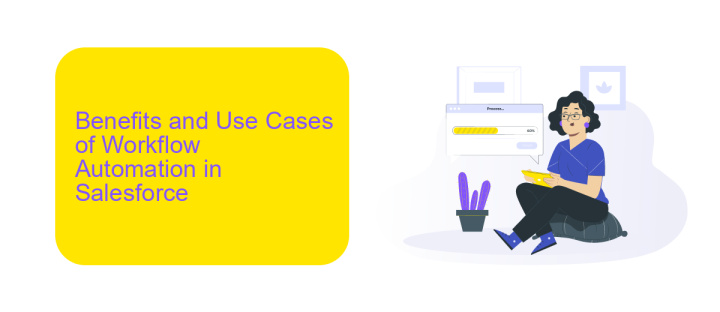Salesforce Workflow Automation
Salesforce Workflow Automation revolutionizes the way businesses operate by streamlining repetitive tasks and enhancing productivity. By automating routine processes, companies can focus on strategic initiatives, reduce human error, and improve overall efficiency. This powerful tool not only saves time but also ensures that critical workflows are executed consistently, providing a seamless experience for both employees and customers.
Understanding Salesforce Workflow Automation
Salesforce Workflow Automation is a powerful tool designed to streamline and optimize business processes. By automating repetitive tasks, it allows teams to focus on more strategic activities, enhancing overall productivity and efficiency. This system can handle a variety of tasks, from simple email alerts to complex multi-step processes, ensuring that the right actions are taken at the right time.
- Automate routine tasks to save time and resources
- Ensure consistency and accuracy in business processes
- Improve team collaboration and communication
- Integrate with other tools and services for seamless operations
One of the key benefits of Salesforce Workflow Automation is its ability to integrate with various third-party services, such as ApiX-Drive. ApiX-Drive facilitates the connection between Salesforce and numerous other applications, allowing for smooth data transfer and synchronization. This integration capability ensures that your workflows are not only efficient but also comprehensive, covering all aspects of your business operations.
Benefits and Use Cases of Workflow Automation in Salesforce

Workflow automation in Salesforce offers numerous benefits, including increased efficiency, reduced human error, and improved consistency in business processes. By automating repetitive tasks, organizations can free up valuable time for employees to focus on higher-value activities. Additionally, automation ensures that processes are followed consistently, reducing the risk of errors and enhancing overall data accuracy. This leads to better decision-making and more reliable outcomes.
Use cases for workflow automation in Salesforce are vast and varied. Common applications include automating lead assignment, streamlining approval processes, and managing customer follow-ups. By integrating services like ApiX-Drive, businesses can further extend the capabilities of Salesforce, enabling seamless data transfer between different applications and systems. This integration ensures that all relevant information is up-to-date and accessible, enhancing collaboration and efficiency across departments. Overall, workflow automation in Salesforce not only optimizes internal operations but also significantly improves customer satisfaction and business performance.
Step-by-Step Guide to Creating Automated Workflows

Automating workflows in Salesforce can significantly enhance your team's efficiency and productivity. To get started, follow these steps to create your first automated workflow.
- Log in to your Salesforce account and navigate to the Setup menu.
- Under the Process Automation section, select Workflow Rules.
- Click on the "New Rule" button and choose the object you want to create a workflow for.
- Define the criteria that will trigger the workflow, such as specific field values or conditions.
- Specify the actions to be taken when the criteria are met, such as sending an email alert, updating a field, or creating a task.
- Review your workflow rule and activate it.
For more advanced integrations and automated workflows, consider using services like ApiX-Drive. This platform allows seamless integration between Salesforce and other applications, enabling you to automate complex business processes without the need for extensive coding. By leveraging such tools, you can ensure your workflows are both efficient and scalable.
Best Practices and Tips for Effective Workflow Automation

To ensure effective workflow automation in Salesforce, it is crucial to start with a clear understanding of the business processes you aim to automate. Begin by mapping out these processes in detail, identifying key steps and decision points. This foundational step will help you design workflows that truly align with your organizational goals.
Next, focus on simplicity and scalability. Overly complex workflows can become difficult to manage and maintain. Aim to create workflows that are as straightforward as possible, while still meeting your needs. Additionally, consider future growth and how your workflows can scale with your business.
- Regularly review and update workflows to ensure they remain effective.
- Use tools like ApiX-Drive to streamline integrations with other systems.
- Test workflows thoroughly before deployment to catch any potential issues.
- Leverage Salesforce’s built-in analytics to monitor workflow performance.
Finally, involve key stakeholders throughout the process. Their insights can provide valuable feedback and help ensure that the automated workflows meet the needs of all users. By following these best practices, you can optimize your Salesforce workflow automation for maximum efficiency and effectiveness.
Future Trends and Innovations in Salesforce Workflow Automation
The future of Salesforce Workflow Automation is poised for significant advancements, driven by the integration of artificial intelligence and machine learning. These technologies will enable more predictive and adaptive workflows, allowing businesses to automate complex decision-making processes with greater accuracy. Enhanced data analytics will provide deeper insights into workflow performance, helping organizations to continuously optimize their operations. Additionally, the rise of low-code and no-code platforms will democratize automation, empowering non-technical users to create and manage workflows with minimal IT intervention.
Another key trend is the increasing emphasis on seamless integration with third-party applications and services. Tools like ApiX-Drive are revolutionizing this space by offering robust, user-friendly solutions for connecting Salesforce with a wide array of external systems. This will facilitate more cohesive and efficient workflows, as data can flow effortlessly between different platforms. As a result, businesses will be able to achieve higher levels of automation and operational efficiency, ultimately driving better customer experiences and business outcomes.


FAQ
What is Salesforce Workflow Automation?
How can I set up a basic workflow rule in Salesforce?
What types of actions can be automated using Salesforce Workflow Automation?
Can I integrate third-party applications with Salesforce Workflow Automation?
What are some best practices for creating effective workflow rules in Salesforce?
Time is the most valuable resource in today's business realities. By eliminating the routine from work processes, you will get more opportunities to implement the most daring plans and ideas. Choose – you can continue to waste time, money and nerves on inefficient solutions, or you can use ApiX-Drive, automating work processes and achieving results with minimal investment of money, effort and human resources.

